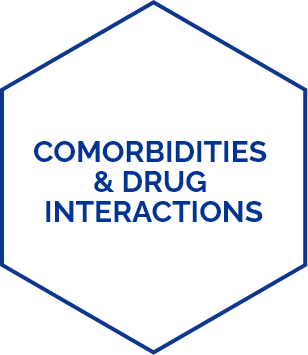CHRONIC LYMPHOCYTIC LEUKEMIA (CLL)

CLL is the most common adult leukemia in the United States.1 It is projected to represent 11% of all newly diagnosed hematological malignancies.2,3 About 195,000 Americans are living with CLL, and the prevalence is predicted to rise due to an aging population, high survival rates, and improved outcomes with novel treatments.2,3 The incidence of CLL has also increased in the last 20 years and is disproportionately affecting the elderly.4 It is estimated that there will be 21,250 new cases in 2021.1
The incidence of CLL is increasing in the US
GIVEN THIS RISING PATIENT POPULATION, TG THERAPEUTICS IS COMMITTED TO ADVANCING THE SCIENCE TO ADDRESS THE GROWING NEEDS IN CLL.
CLL IS GENERALLY CONSIDERED TO BE A CHRONIC AND INCURABLE DISEASE, CHARACTERIZED BY MULTIPLE RECURRENCES AND RELAPSES5,6
CLL is a slow-growing leukemia that begins in the bone marrow or lymph nodes and moves into the peripheral blood.7 It is characterized by the accumulation of leukemic B cells, which are responsible for the onset and worsening of symptoms in patients.7 Patients with CLL are most often asymptomatic at the time of diagnosis and become aware of their disease following the detection of an elevated lymphocyte count during routine bloodwork.7
While CLL is a slow-growing malignancy, it is incurable, and most patients will eventually relapse.5,6 As the number of lines of therapy received by a patient increases, responses to each subsequent therapy and survival rates decrease.5 As such, CLL progression and/or disease-related complications are the primary causes of death, independent of age and comorbidities, highlighting the unmet need in this disease area.8 Additionally, many patients in remission will still have a low level of leukemia cells, or minimal residual disease (MRD).9 Lab tests can measure for the presence of these residual cells.9 An MRD negative lab result is defined as undetectable MRD (uMRD), or the presence of extremely low levels of leukemia cells to normal white blood cells.9 Current efforts are underway exploring how to improve rates of uMRD (or undetectable leukemia cells), in order to continually suppress disease.9
AS THE NUMBER OF LINES OF THERAPY INCREASES, OVERALL SURVIVAL RATES DECREASE—HIGHLIGHTING THE UNMET NEED IN THIS DISEASE AREA.5
FOR PATIENTS WITH CLL, THERE ARE MULTIPLE FACTORS TO CONSIDER WHEN MAKING TREATMENT DECISIONS8,10
Modern treatments for CLL have led to improvements in survival rates and patient outcomes.2 However, because CLL is most commonly diagnosed in the elderly, comorbidities (eg, risk of cardiovascular events, hypertension, or renal insufficiency) and interactions with other medications often complicate treatment decisions and the ability to take or benefit long-term from current therapies.8,10 Intolerance to currently available therapies is also common in the elderly and can lead to the discontinuation of certain therapies.10,11 Long-term benefit is also dependent upon duration of response to therapy, and many patients will develop acquired resistance to currently available novel agents.12-14 A better understanding of CLL pathophysiology may help address acquired resistance, as well as the chronic and relapsing nature of this disease.14
Factors affecting long-term treatment with current agents



CLL REMAINS A CHALLENGING DISEASE FOR PATIENTS WHO ARE UNABLE TO RECEIVE, UNABLE TO TOLERATE, OR ACQUIRE RESISTANCE TO CURRENT THERAPIES.8,10-14
PATHOPHYSIOLOGY OF CLL
In CLL there are a significant number of leukemia cells that circulate in the blood in addition to the bone marrow and lymphoid tissues.15,16 Targeting multiple pathways in these multiple compartments may have the potential to improve efficacy by increasing MRD negativity, keeping disease suppressed, and avoiding the development of acquired resistance.17-19 There is additional need for combination therapies that can act on leukemia cells in multiple compartments.15,16
CLL cells are present within multiple compartments

BONE
MARROW

PERIPHERAL
BLOOD

LYMPHOID
TISSUES
COMPONENTS WITHIN THE B-CELL RECEPTOR (BCR) SIGNALING PATHWAY ARE DRIVERS OF CLL16,20
Because CLL arises from the uncontrolled proliferation of B cells, the BCR signaling pathway plays an important role in driving the proliferation and survival of CLL cells.16 CD20 is a cell surface molecule that sits adjacent to the BCR, and plays a role in BCR signaling.16,21 Activation of the BCR pathway results in further activation of downstream kinases, such as spleen tyrosine kinase (SYK), bruton tyrosine kinase (BTK), and phosphoinositide-3 kinase (PI3K).16
Downstream kinases within the BCR signaling pathway
SYK
SYK plays a role in CLL cell adhesion.22
BTK
BTK is important for cell proliferation, differentiation, and allows CLL cells to communicate with the immune microenvironment.16,22
PI3K-delta
PI3K-delta promotes cell proliferation, survival, and migration of malignant B cells.22
When treating CLL, data has shown it may be beneficial to target multiple kinases within the BCR signaling pathway (ie, BTK and Pi3K).17,18,23 In addition, targeting other features of CLL biology, such as BCL2 or CD20, can be complementary to inhibition of BCR signaling.16,21
THERE CONTINUES TO BE A NEED TO DEVELOP NEW THERAPIES TO BLOCK BCR SIGNALING FROM MULTIPLE ANGLES.17,18,21,23
CLINICAL RESEARCH IN CLL
TG Therapeutics is committed to researching multiple targets in CLL, including combination therapy and its effects on MRD negativity. Several phase 2B and phase 3 combination trials are now underway.
References: 1. Siegel RL, et al. CA Cancer J Clin. 2021;71(1):7-33. 2. Chen Q, et al. J Clin Oncol. 2017;35(2):166-174. 3. National Cancer Institute. SEER Cancer Stat Facts: Leukemia—Chronic Lymphocytic Leukemia. https://seer.cancer.gov/statfacts/html/clyl.html. Accessed October 22, 2021. 4. Hao T, et al. Sci Rep. 2019;9(1):12070. 5. Mato A, et al. Blood Adv. 2020;4(7):1407-1418. 6. Sharma S, et al. Cancer. 2019;125(9):1432-1440. 7. Mukkamalla SKR, et al. Chronic Lymphocytic Leukemia. In: StatPearls. Treasure Island (FL): StatPearls Publishing; October 1, 2021. 8. Strati P, et al. Br J Haematol. 2017;178(3):394-402. 9. Del Giudice I, et al. Front Oncol. 2019;9:689. 10. Hardy-Abeloos C, et al. J Hematol Oncol. 2020;13(1):66. 11. Mato AR, et al. Haematologica. 2018;103(5):874-879. 12. Blombery P, et al. Blood. 2020;135(10):773-777. 13. Cheng S, et al. Leukemia. 2015;29(4):895-900. 14. Fatima N, et al. Cancer Drug Resist. 2020;3:532-549. 15. Herndon TM, et al. Leukemia. 2017;31(6):1340-1347. 16. Burger JA. N Engl J Med. 2020;383(5):460-473. 17. Sharman JP, et al. Br J Haematol. 2017;176(3):412-420. 18. Burger JA, et al. Nat Rev Cancer. 2018;18(3):148-167. 19. Tang X, et al. Clin Exp Med. 2021;10. 20. Dong S, et al. J Clin Invest. 2019;129(1):122-136. 21. Pavlasova G, et al. Haematologica. 2020;105(6):1494-1506. 22. Burger JA, et al. Trends Immunol. 2013;34(12):592-601. 23. Choudhary GS, et al. Cell Death Dis. 2015;6(1):e1593.

